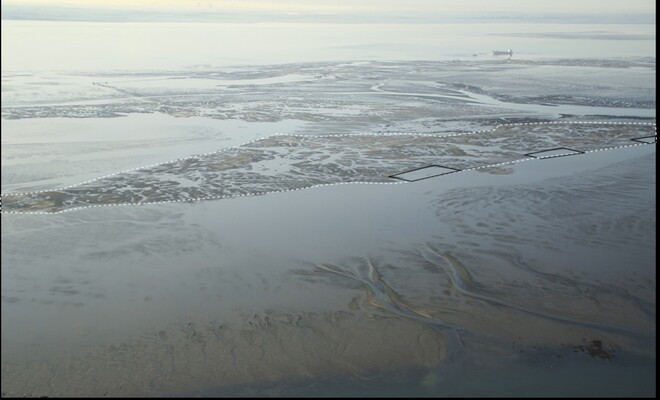Jim van Belzen1,2,*, Vincent Escaravage2, Tim Grandjean1, Jeroen van Dalen1, Lodewijk de Vet3, Brenda Walles1,4 & Tjeerd J. Bouma1
1NIOZ; 2Wageningen Marine Research; 3Deltares; 4Delta Climate Center
*corresponding author: jim.van.belzen@nioz.nl
Introduction
Estuaries worldwide are under pressure from climate change and human activities. To protect coastal communities from flooding, many estuaries have been (semi-)closed by storm surge barriers. However, these structures disrupt hydrodynamic processes, leading to estuarine "drowning"—a phenomenon often exacerbated by sea-level rise. The Oosterschelde (Netherlands) is one such drowning former estuary, undergoing system-wide erosion since the construction of a storm surge barrier and compartmentalization dams in the 1980s. This erosion results in the loss of intertidal areas, which are critical foraging grounds for shorebirds. Since removing barriers is not a short-term management option, mitigation measures are needed. To counteract intertidal loss, sand nourishments have been implemented since 2008—starting with small-scale pilot projects and gradually increasing in scale and ambition.
Objective and Methods
Despite the necessity of tidal flat nourishments to restore and maintain foraging habitats for shorebirds, these interventions can be highly disruptive to their food source, the benthic communities. Investigating methods to reduce this impact is therefore crucial.
In this study, we tested whether priming nourishments with local sediment can enhance recovery of the benthic community during a large-scale nourishment operation. In autumn 2019, a 1.13 Mm³ nourishment was carried out on the Roggenplaat (Oosterschelde) to compensate for bird foraging habitat loss. This nourishment consisted of seven distinct elements, varying in location, elevation, and sediment thickness.
On one nourishment element, we tested a priming approach by relocating local sediment rich in benthic fauna by piling it up before embedding it within a standard nourishment with nonlocal sediment (sourced from the channel). We also applied cockle-seeding: i.e., cockles were seeded on top of the nourishment whereafter the animals had to burry themselves in. The experiment consisted of 12 plots divided into four treatments: (1) 3 pots with standard (non-primed) nourishment; (2) 3 plots with sediment priming; (3) 3 plots with cockles seeding; and (4) 3 control plots were established in the surrounding undisturbed tidal flat.
Results
We found that nourished areas primed with local sediment recovered significantly faster than plots seeded with cockles or standard (non-primed) nourishment plots. Immediately after nourishment, primed plots exhibited higher biomass, suggesting that this approach partly preserves the benthic community. One year after nourishment, the primed plots were nearly fully recovered. This accelerated recovery is likely due to the retention of key soil properties (e.g., grain size and organic matter content) that remained closer to pre-nourishment conditions. Additionally, benthic community development in primed plots progressed faster than expected based on nourishment thickness alone. This faster initial recovery is particularly beneficial for shorebirds, as (non-primed) nourishments recover slowly, especially thicker nourishments are taking years before they become valuable foraging grounds again. Our findings suggest that sediment priming could be a valuable strategy to enhance the ecological quality of nourishments. Our results underscore the need for further testing this technique to improve the recovery and ecological function of tidal flat nourishments e.g. by priming local sediment on top of thicker less quickly recovering nourishments.

Supplementation element 2 from the northeast (dashed white outlined polygon) and the embedded priming plots (black outlined polygons).










